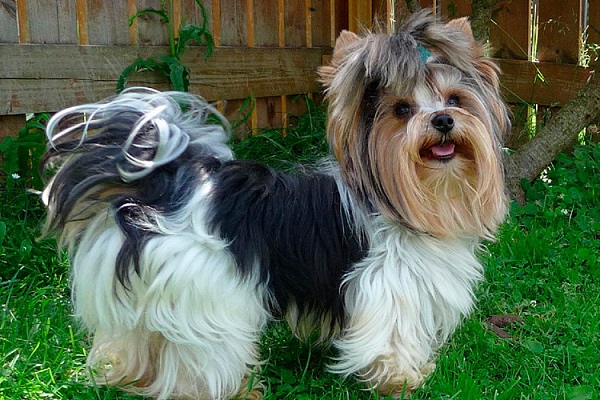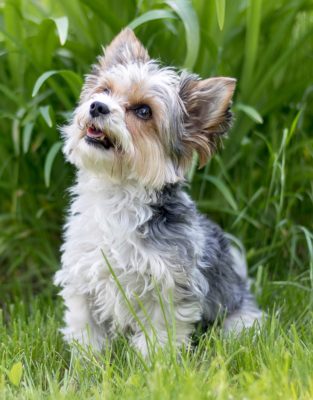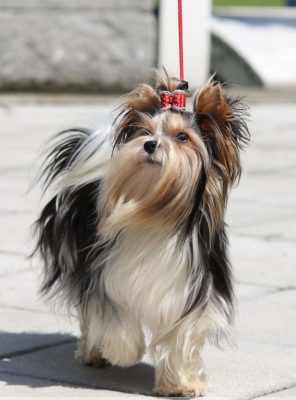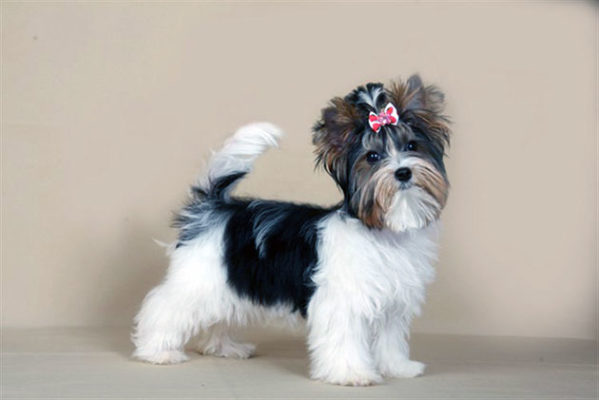Beaver Yorkshire Terrier

The character of the Beaver Yorkshire Terrier is very similar to the standard Yorkshire Terrier, but the ability to hunt has been lost. In general, it is a cheerful dog with an active attitude. It learns the world around it with interest, willingly comes into contact with other people and animals. With children, Beaver Terriers quickly find a common language. You only need to explain that you should not touch the dog while he’s sleeping or feeding, as this can disturb his psyche.
Table of Contents
Breed Information
| Another Name | Biewer Terrier |
| Origin | Germany |
| Height | Males 15-23 cm Females 10-18 cm |
| Weight | 1.8-3.6 kg |
| Fur | Very thick grows to the floor in length |
| Color | Black and white or blue and white as well as full black or full blue with a white jabot |
| Lifespan | 12-16 years |
| FCI Classification | Breeds outside the FCI classification |
| Group | Small breed or decorative dogs |
| Price | From $500 |
Breed Photos
Origin History
The Beaver Yorkshire Terrier is a separate subspecies of the Yorkshire Terrier. The breed’s history began with a litter of white-spotted puppies born to a German Yorkie breeder in the 1980s. Werner and Gertrude Beaver had been breeding for about 20 years and were very interested in this breeding.
They introduced black and white Yorkies at a show in Wiesbaden. A year later, they were registered in Germany, but it was not until 2007 that the final breed standard was signed.
It is an interesting fact that in the name of the breed, you can see the prefix “a la Pom-Pon”, which translates to “colored ball of yarn”. The prefix originated from German singer Margot Eskens when her husband gave her a black and white puppy.
Appearance
This breed is commonly referred to as a “toy that came to life” because of its appearance. The Beaver Yorkshire Terrier differs from ordinary Yorkshire Terriers in the shade of its coat. The head is proportional to the body. The neck is well defined and quite long. The eyes are medium-sized, usually of a darker shade. The ears are upright, triangle-shaped, set high. The teeth have a straight or scissor-shaped bite. The body is elongated; the tail is not cropped. The chest is well developed. The limbs are straight. The hair of the Biewer Terrier is very thick; the length of the hair grows to the floor. Chest, paws, and abdomen are always white. The body of the pet is usually white-blue, black and white, or bluish. There are also patches of black, white, or sandy hue on the head. Biewer Terriers tend to change their coat shade with age, depending on their genotype.
Character
The character of the Beaver Yorkshire Terrier is very similar to the standard Yorkshire Terrier, but the ability to hunt has been lost. In general, it is a cheerful dog with an active attitude. It learns the world around it with interest, willingly comes into contact with other people and animals. With children, Biewer Terriers quickly find a common language. You only need to explain that you should not touch the dog while he’s sleeping or feeding, as this can disturb his psyche.
The pets are great for keeping in an apartment. They retain their childlike spontaneity for life. At the same time, Biewer Terriers are very smart; once and for all, remember the house rules. The doggie is adapted to travel with the owner, so it is easy to get accustomed to a new place. It’s better to take it with you than leave it with strangers. It will only cause stress for the Biewer Terrier.
Despite their small size, they are always ready to protect themselves and their owner if they feel threatened. Some owners of Beaver Yorkshire Terriers start to spoil their cute pets. But this doesn’t seem right; a pampered dog can be a big problem.
Care
There are no special recommendations for the care of the Beaver Yorkshire Terrier. He should be bathed once a month with a special shampoo for long-haired dogs. The silky hair grows quickly, so the Biewer Terrier, like other Yorkies, needs to be trimmed. Even if he’s not a show dog, it will only make life easier. Wear warm clothing and special shoes in winter to protect his feet from road debris. Keep an eye on his ears and brush them after bathing or a brisk walk. Nails should be trimmed several times a month.
Beaver Yorkshire Terriers can be stubborn and refuse to perform tasks during training. But if you find an approach to the pet, you can teach even circus tricks.
Training
It is best to start training with the most basic rules, such as not taking food from your hands, going to the toilet in the right place, not pulling the leash. Only then can you burden the dog with learning commands. They can already recognize their owners at a young age. Successful training depends on an emotional understanding of the dog and the owner.
A good tactic would be to reward at the end. You can take the tasty rewards with you on your walk and train your pet outdoors.
Physical punishment should be avoided. Dogs are susceptible even to the owner’s intonation and will immediately sense an angry note.
Common Diseases
Beaver Yorkshire Terriers have good immunity but don’t take any chances and walk your dog without clothes in cold weather. These dogs are prone to bronchitis. After a walk, check your pet’s coat for pests.
Beaver Yorkshire Terrier teeth are prone to early decay. It should be noted that this breed does not tolerate anesthesia well.
Biewer Terrier is prone to such diseases:
- dislocation of the kneecap;
- gum disease;
- eye irritation;
- extrahepatic shunt – surgical intervention is required;
- pancreatitis.
Nutrition
Beaver Yorkshire Terriers are prone to obesity. Therefore, it is worth controlling the portions of the pet and does not forget about physical activity. The dog should be fed three times a day. The diet should be balanced. The dog will benefit from lean meat, cereals, and vegetables. Don’t forget vitamin supplements to maintain coat quality. Don’t forget the fats found in dairy products. Water should always be readily available for the Beaver Yorkshire Terrier.



